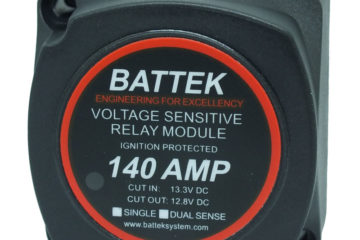
One of the best approach to charge two batteries in a boat or a vehicle from a single charging source is to use a Voltage Sensitive Relay (VSR). This device connects a secondary battery to the primary battery and charging current source whenever the voltage of the primary battery exceeds about 13.3 Volts DC. In this way, the secondary battery only receives charging current after the primary battery has been charged to a voltage which normally indicates full-charge has been restored in the primary battery .
The beauty of this wiring arrangement is to concentrate first on charging of the primary battery, which is usually the engine starting or cranking battery, and only provide charging current to the secondary or house battery when the primary battery has been fully re-charged. In this way the system assures that the engine starting battery will always be kept at a high charge level, and charging of the house battery will never divert current needed for the starting battery.
For optimum performance, the capacity of the secondary battery and the charging current available need to be matched up. This is necessary to prevent the system from going into an oscillation. Here is what can happen if the charging current available is too small and the secondary battery is too large:
When the charging current has raised the voltage on the primary battery to a level above the threshold of the VSR, the secondary battery is connected in parallel. Typically the addition of the second battery will cause some drop in voltage in the charging current output and primary battery. If this voltage drop is excessive, it will fall below the threshold of the VSR and the device will disconnect the secondary battery. Once that happens the voltage rises, again, and this pushes it above the the threshold of the VSR. The two batteries are connected, and the voltage drops. This sets up an oscillation or chatter of the VSR.
To prevent this hysteresis is implemented in the control loop of the VSR so that the cut-in threshold and the cut-off threshold are separated by a margin of appropriate voltage. However, if the secondary battery is too large and the charging current source too small, the system will still oscillate or chatter, in spite of the hysteresis in the control loop. This can occur if the secondary battery is very large and the charging current is marginal.


